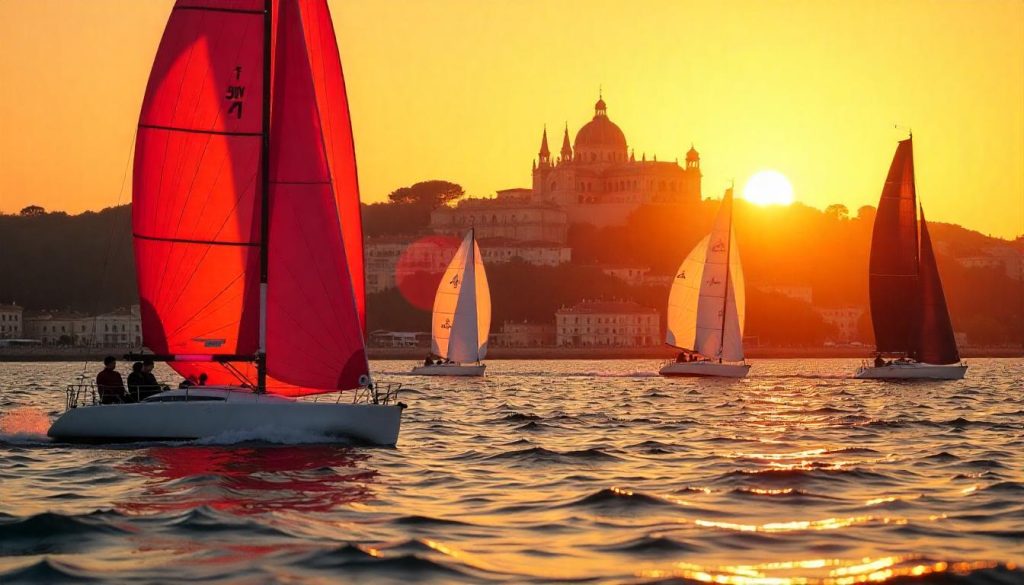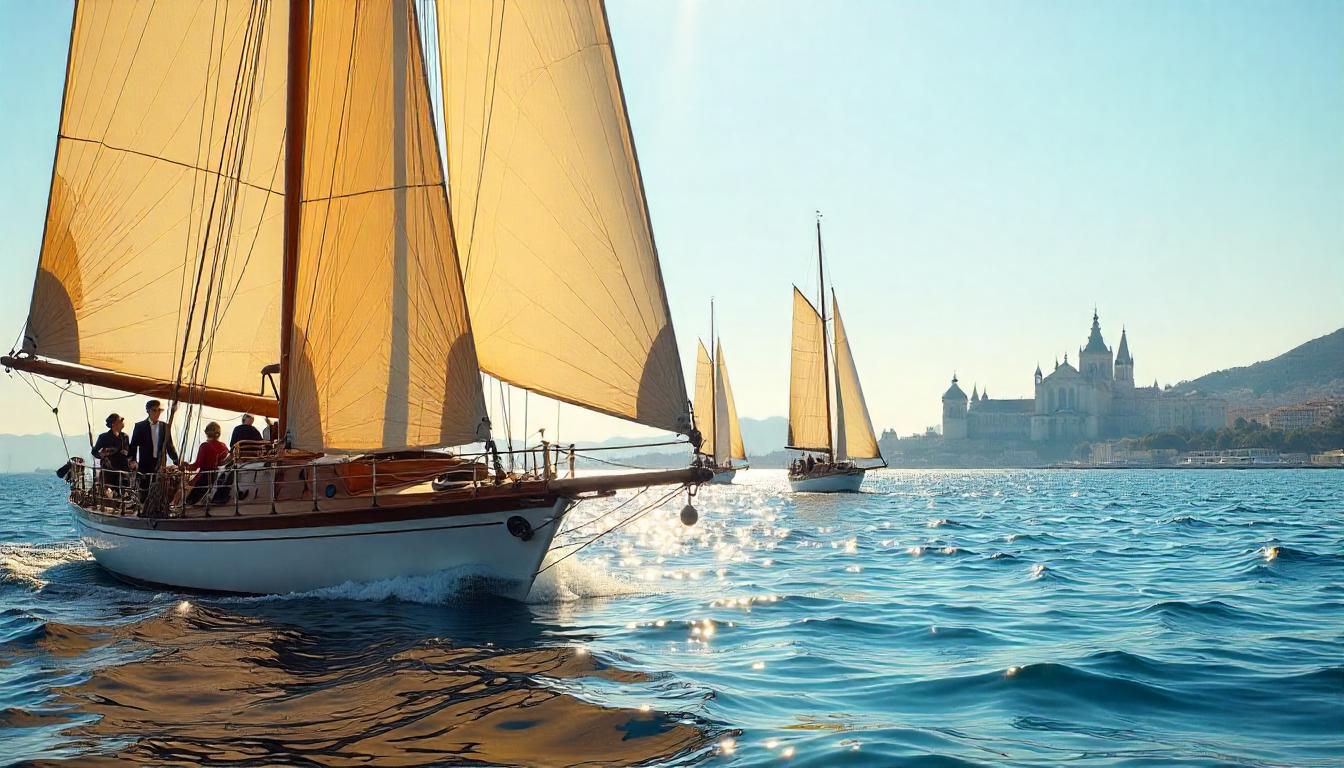Spain, with its 8,000 km of coastline and deep maritime roots, has a rich legacy of sailing, and the history yachting Spain offers traces the evolution of this seafaring tradition from ancient times to the modern era. From the Phoenicians navigating the Mediterranean to the glamorous regattas of today, yachting in Spain has grown into a cultural and recreational cornerstone, blending history with innovation. In this article, we’ll explore the history yachting Spain provides, highlighting key milestones, influential figures, and the contemporary yachting scene as of April 2025.
Ancient Beginnings: The Early History Yachting Spain
The history yachting Spain offers begins with the ancient civilizations that sailed its waters. Around 1200 BCE, the Phoenicians, skilled seafarers from the eastern Mediterranean, established trading posts along Spain’s southern coast, including Cádiz, one of the oldest continuously inhabited cities in Europe. They used small wooden boats, about 15 meters long, to transport goods like olive oil and wine, navigating with basic sails and oars. Also, the Iberians, native to the peninsula, developed their own vessels, often depicted in cave paintings near Alicante, showing early maritime activity.
Roman and Moorish Influences
The Romans, who arrived in Spain around 218 BCE, further advanced maritime practices. For instance, they built larger ships, up to 30 meters, for trade and military purposes, using the port of Tarragona as a hub. Additionally, during the Moorish rule from the 8th to 15th centuries, Arab shipbuilders introduced the lateen sail, a triangular sail that improved maneuverability, influencing Spanish boat design. Transitioning to culture, the Moors also brought navigational tools like the astrolabe, enhancing Spain’s maritime capabilities. Thus, these early influences laid the groundwork for Spain’s yachting history.
The Age of Exploration: A Turning Point in History Yachting Spain
The 15th and 16th centuries marked a pivotal era in the history yachting Spain provides, as the Age of Exploration elevated Spain to a global maritime power. Christopher Columbus’ 1492 voyage to the Americas, sponsored by the Spanish Crown, was a defining moment, using caravels—small, agile ships about 20 meters long with lateen sails. These vessels, built in Spanish shipyards like those in Seville, were precursors to modern yachts, designed for long-distance travel. Also, Ferdinand Magellan’s circumnavigation of the globe (1519-1522) further showcased Spain’s shipbuilding prowess.
The Role of the Spanish Armada
The Spanish Armada, established in the 16th century, solidified Spain’s naval dominance. For example, the Armada’s galleons, up to 40 meters long, were heavily armed and used for both war and exploration, patrolling the Mediterranean and Atlantic. However, the Armada’s defeat in 1588 by England marked a decline in Spain’s naval power, shifting focus to smaller, recreational vessels. Transitioning to leisure, by the late 17th century, Spanish nobility began using these smaller boats for pleasure cruises along the Costa del Sol, an early form of yachting. Therefore, the Age of Exploration shaped Spain’s maritime legacy.
The 19th Century: The Birth of Modern Yachting in Spain
The 19th century saw the birth of modern yachting in Spain, as the history yachting Spain offers entered a new phase. In 1831, the Real Club Náutico de Barcelona was founded, one of the oldest yacht clubs in Spain, marking the formalization of recreational sailing. The club organized its first regatta in 1835, with 10 yachts racing in the Bay of Barcelona—boats were typically 15-20 meters long, made of wood, and owned by wealthy aristocrats. Also, the Industrial Revolution brought steam-powered yachts, though sailboats remained popular for sport.
The Rise of Regattas and Yacht Clubs
Regattas became a social event for Spain’s elite. For instance, the Real Club Náutico de Palma, founded in 1948 but with roots in the 19th century, began hosting races in the Bay of Palma, where winds average 10-15 knots, ideal for sailing. Additionally, the Spanish royal family, particularly King Alfonso XIII, played a key role—he owned a yacht named Hispania, built in 1909, and competed in international races, boosting yachting’s popularity. Transitioning to infrastructure, by the late 19th century, marinas like Puerto Banús in Marbella began to emerge, catering to the growing yachting community. Thus, the 19th century set the stage for modern yachting in Spain.

The 20th Century: Growth and Glamour in History Yachting Spain
The 20th century brought significant growth to the history yachting Spain provides, as the sport became more accessible and glamorous. Post-Civil War (1936-1939), Spain’s tourism boom in the 1950s and 60s, particularly in the Costa del Sol and Balearic Islands, fueled yachting’s rise. Marinas like Marina Ibiza, established in 1965, offered berths for yachts up to 60 meters, with mooring fees around $90 per night today. Also, the 1960s saw the introduction of fiberglass hulls, making yachts lighter and more affordable—prices dropped from $50,000 to $20,000 for a 30-foot yacht.
The Emergence of Major Regattas
Major regattas gained prominence in the 20th century. For example, the Copa del Rey MAPFRE, launched in 1982 in Palma, became a Mediterranean highlight, attracting over 100 yachts annually by the 1990s. Additionally, the 1992 Barcelona Olympics, which included sailing events in the city’s port, showcased Spain’s yachting infrastructure to the world, with 405 sailors competing across 10 classes. Transitioning to culture, celebrities like Grace Kelly and Frank Sinatra were spotted yachting in Mallorca, adding a glamorous allure. Therefore, the 20th century transformed yachting into a mainstream activity in Spain.
The Modern Era: History Yachting Spain in 2025
As of April 2025, the history yachting Spain offers has evolved into a thriving industry, blending tradition with innovation. Spain now boasts over 300 marinas, with facilities like Marina Port Vell in Barcelona offering berths for yachts up to 190 meters at $110 per night. The country hosts world-class events, such as the Louis Vuitton 37th America’s Cup, held in Barcelona in 2024, which featured AC75 foiling yachts reaching speeds of 50 knots and drew 50,000 spectators daily. Also, the Puig Women’s America’s Cup highlighted female sailors, a milestone for inclusivity.
Technology and Sustainability in Yachting
Technology has revolutionized modern yachting. For instance, hybrid yachts with electric engines, like those from Sunreef Yachts, are gaining popularity in Spain, reducing emissions by 30%—prices start at $1 million for a 40-foot model. Additionally, marinas are adopting sustainable practices—Puerto Portals in Mallorca now uses solar panels to power 50% of its operations. Transitioning to events, the 2025 Copa del Rey MAPFRE, set for July 27 to August 3, will feature a “green regatta” initiative, encouraging eco-friendly practices among participants. Thus, the modern era reflects a commitment to sustainability while honoring Spain’s yachting heritage.
Key Figures in the History Yachting Spain
Influential figures have shaped the history yachting Spain provides over the centuries. King Alfonso XIII, an avid sailor in the early 20th century, promoted yachting through his participation in races, inspiring the creation of regattas like the Copa del Rey. In the modern era, Spanish sailor Alex Pella set a round-the-world speed record in 2017, completing the Jules Verne Trophy in 40 days aboard the maxi-trimaran IDEC Sport. Also, female sailors like Támara Echegoyen, a 2012 Olympic gold medalist, have elevated Spain’s global yachting profile.
Cultural Impact of Yachting
Yachting has left a cultural mark on Spain. For example, the Illes Balears Classics regatta in Mallorca, held annually since 1995, celebrates maritime heritage with vintage yachts like the 1909 Tuiga, drawing 5,000 spectators. Additionally, yachting has influenced Spanish art—Salvador Dalí’s paintings often featured boats, inspired by his time in Cadaqués, a popular yachting spot. Transitioning to tourism, yachting contributes $2 billion annually to Spain’s economy, supporting coastal towns like Palamós. Therefore, yachting is deeply woven into Spain’s cultural fabric.
Challenges in the History Yachting Spain
Yachting in Spain has faced challenges over time. First, the Spanish Civil War (1936-1939) halted recreational sailing, as resources were diverted to military efforts. Additionally, the 2008 financial crisis impacted yachting—marina occupancy in Mallorca dropped by 20%, and yacht sales fell 30%. Also, environmental concerns, like plastic pollution in the Mediterranean, have pressured the industry to adopt sustainable practices—marinas now charge $5 per yacht for waste disposal. However, these challenges have spurred innovation.
Overcoming Historical Challenges
Spain has adapted to these challenges. For instance, post-Civil War, the 1950s tourism boom revived yachting, with new marinas built in Ibiza and Mallorca. After the 2008 crisis, the industry recovered by 2015, thanks to increased tourism—yacht charters rose by 15% annually. Transitioning to sustainability, events like the 2025 Copa del Rey now promote eco-friendly practices, such as banning single-use plastics. Thus, Spain’s yachting industry has shown resilience throughout its history.
Why Explore the History Yachting Spain?
The history yachting Spain offers provides a fascinating journey through time, from ancient Phoenician traders to modern eco-conscious regattas, reflecting Spain’s enduring love for the sea. This history showcases the country’s maritime innovation, cultural impact, and global influence in sailing. Whether you’re a history buff or a sailing enthusiast, Spain’s yachting story captivates. For a deep dive into maritime heritage, this is the place. Therefore, exploring this history enriches your understanding of Spain’s coastal legacy.
A Journey Through Yachting History
Every era offers unique insights. For instance, imagining Phoenician boats docking in Cádiz connects you to ancient trade routes. Or, watching the 2025 Copa del Rey in Palma links you to a centuries-old tradition of regattas. This historical journey ensures a deeper appreciation of yachting. Thus, the history yachting Spain provides is a story worth exploring.
Final Thoughts on the History Yachting Spain
The history yachting Spain offers spans millennia, from ancient mariners to modern regattas, weaving a rich tapestry of maritime tradition and innovation. By understanding this history, you’ll gain a deeper appreciation for Spain’s coastlines and the sport of yachting. So, whether you’re sailing in Mallorca or visiting a maritime museum in Barcelona, let Spain’s yachting history inspire your next adventure—one wave at a time.

 Історія яхтингу в Іспанії: Від минулого до сьогодення">
Історія яхтингу в Іспанії: Від минулого до сьогодення">
